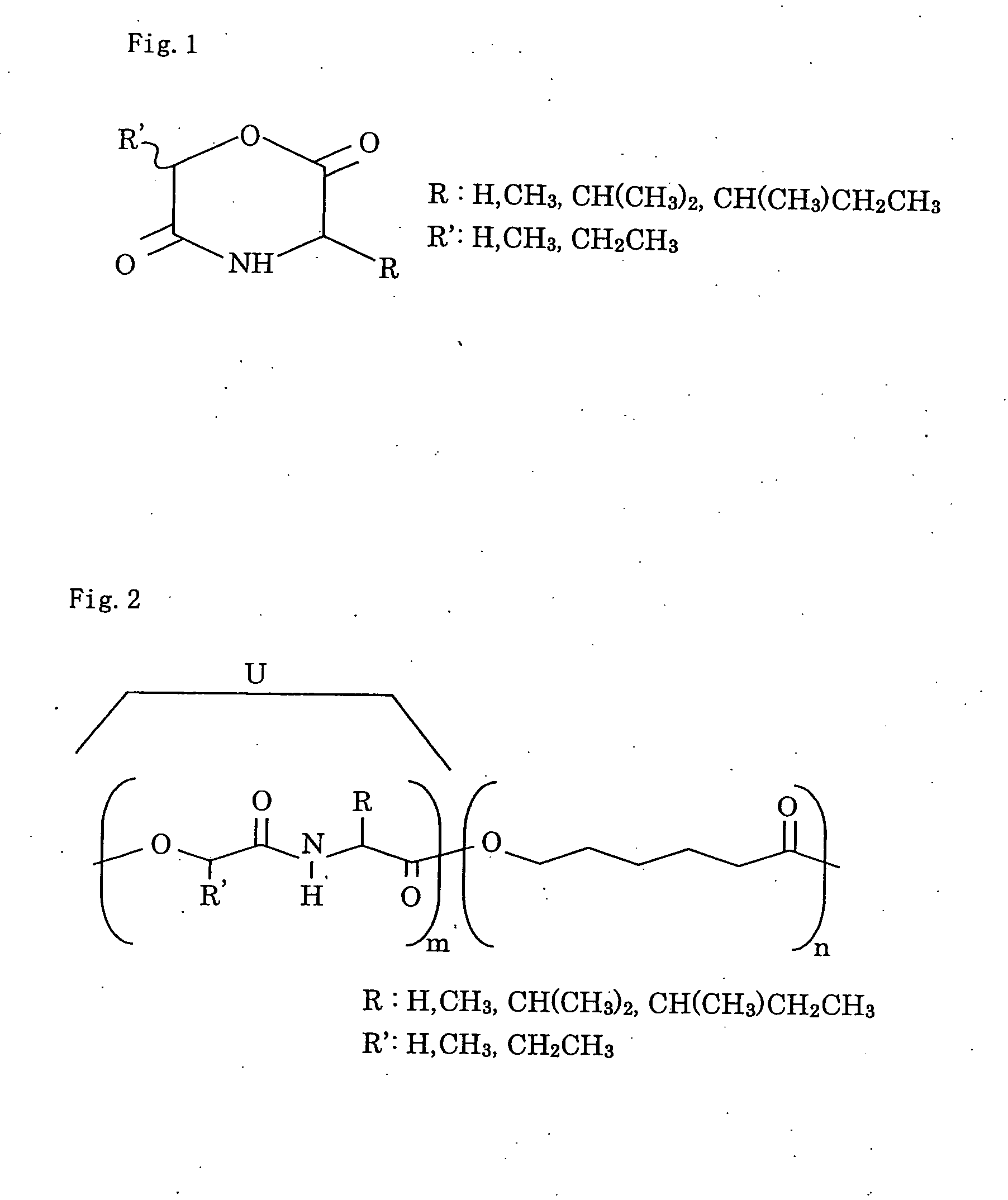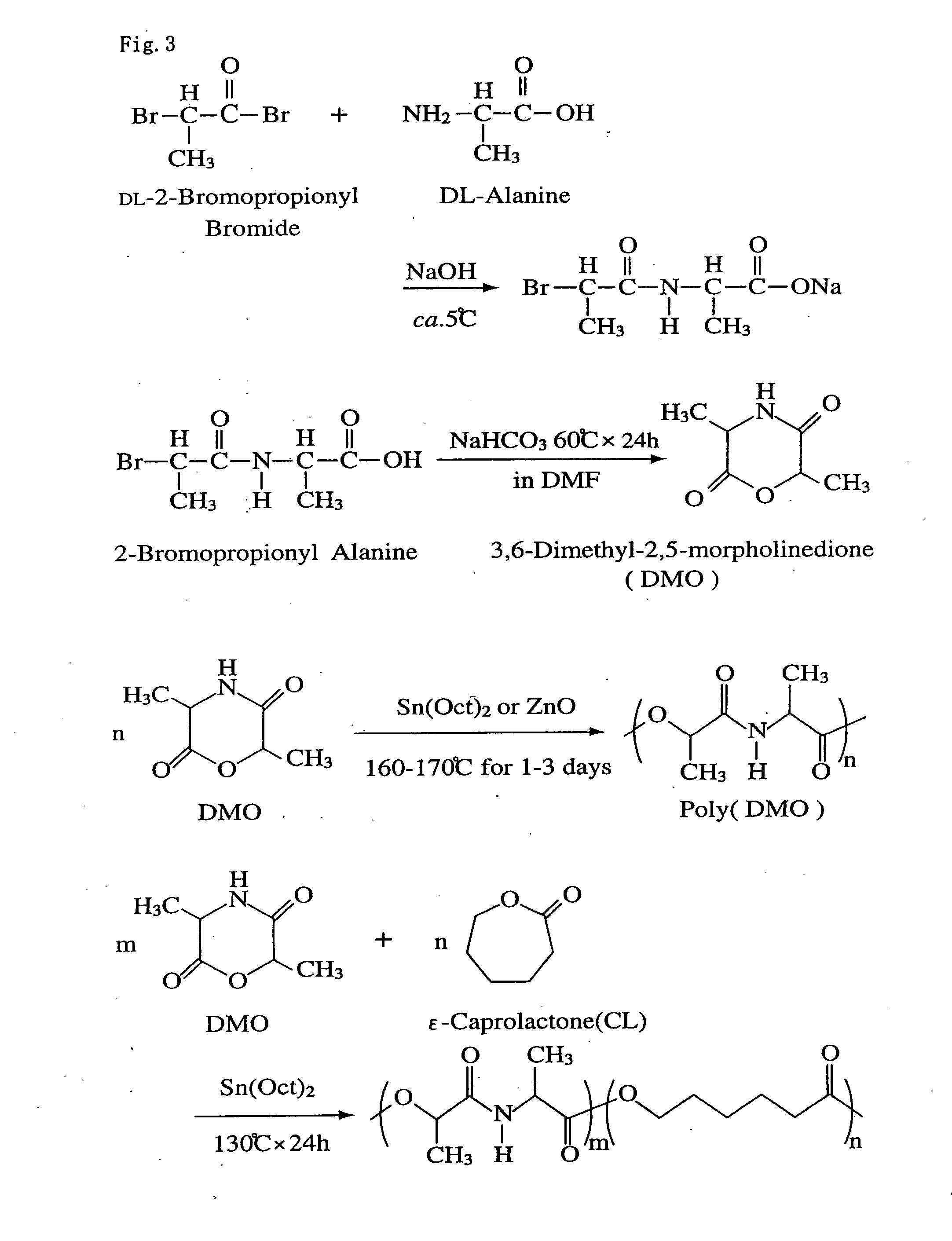Biodegradable bio-absorbable material for clinical practice and method for producing the same
- Summary
- Abstract
- Description
- Claims
- Application Information
AI Technical Summary
Benefits of technology
Problems solved by technology
Method used
Image
Examples
first embodiment
[0025] A tercopolymer was prepared by adding a cyclic depsipeptide (DMO) to a copolymer of L-lactide (L-LA) as a raw material of polylactic acid and ε-caprolactone as a raw material of poly ε-caprolactone.
[0026]FIG. 2 is the structure view of the copolymer with the peptide unit as recovered by the polymerization of the depsipeptide. U expresses depsipeptide unit.
[0027] Therefore, 3,6-dimethyl-2,5-morpholine-dione (DMO) was synthetically prepared as a cyclic depsipeptide. The cyclic depsipeptide is a cyclic ester amide prepared from α-amino acid and a α-hydroxylate derivative. Herein, DL-alanine and DL-2-bromopropionyl bromide were used as α-amino acid and α-hydroxylate derivative, respectively.
[0028] At the first step of the synthesis, the Schotten-Baumann reaction between alanine and 2-bromopropionyl bromide was carried out in an aqueous alkaline solution, for peptide linking to prepare 2-bromopropionyl alanine (FIG. 3).
[0029] In other words, 150 ml of an aqueous solution of DL...
second embodiment
[0063] In case of the recovery of the copolymer of a depsipeptide ring-opened and polymerized, resulting from the copolymerization of a raw material of polyε-caprolactone, namely ε-caprolactone, the structure of the copolymer with the peptide unit is shown in FIG. 2. U expresses the depsipeptide unit. The procedure also imparted mechanical strength and increased degradation rate as in the first embodiment.
[0064] So as to elucidate the influence of the depsipeptide unit in the copolymer with the peptide units, further, the R group in the side chain in the depsipeptide was modified into methyl group, isopropyl group or isobutyl group, to examine the influence. FIG. 8 shows the degradation levels of the copolymers with the depsipeptide units.
The figure shows that the degradation level is in the order of methyl group >>isopropyl group >isobutyl group. It is shown that the increase of the bulkiness of the side chain decreases the degradation level.
third embodiment
3-Isopropyl-6-methyl-2,5-morpholine-dione (PMO) used as a depsipeptide was copolymerized with poly ε-caprolactone, to prepare a copolymer, where the depsipeptide was ring-opened and polymerized.
Then, the changes of the thermal properties and degradation rate in case of the change of the depsipeptide amount were examined. FIG. 14 shows the relation of the thermal properties, while FIG. 9 shows the relation of the degradation rate.
[0065] According to the results, the glass transition temperature (Tg) was elevated as the depsipeptide amount increased. At the amount of ε-caprolactone at 20 mol% or less, the melting point (Tm) and the melting heat (Δ Hm) were observed, indicating that the resulting copolymer was crystallizable.
The degradation rate was elevated as the amount of the depsipeptide increased.
[0066] Herein, the description in the individual embodiments has been done, exemplifying poly ε -caprolactone and polylactic acid as the bio-absorbable polymers. However, the bio-a...
PUM
| Property | Measurement | Unit |
|---|---|---|
| Fraction | aaaaa | aaaaa |
| Tensile strength | aaaaa | aaaaa |
| Biodegradability | aaaaa | aaaaa |
Abstract
Description
Claims
Application Information
 Login to View More
Login to View More - R&D
- Intellectual Property
- Life Sciences
- Materials
- Tech Scout
- Unparalleled Data Quality
- Higher Quality Content
- 60% Fewer Hallucinations
Browse by: Latest US Patents, China's latest patents, Technical Efficacy Thesaurus, Application Domain, Technology Topic, Popular Technical Reports.
© 2025 PatSnap. All rights reserved.Legal|Privacy policy|Modern Slavery Act Transparency Statement|Sitemap|About US| Contact US: help@patsnap.com



